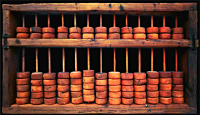








The early calculating instrument we know as the abacus-consisting of a wooden frame supporting wires or rods on which wooden beads slide from side to side-was developed in Mesopotamia from a flat,sand-covered,stone counting board on which pebbles were moved.This aid to calculation was in use long before the adioption of the Hindu-Arabic numeral system and can be used to record very large numbers accurately.
The easiest type of abacus to understand is the modern western version that uses a base of ten.Here each wire carries ten beads and represents a decadal unit,that is one,ten,100,1,000 and so on.A number,say 617,483, can be represented by positioning the respective number of beads,on each wire,against one side of the abacus.it is then a relatively easy task to add or subtract another number from the first one.
After a calculation,the whole abacus can also be reset for further computing by a simple shake.
Abaci were widely used throughout the ancient world and are still important as a teaching aid in pre-school.The ovement of the beads helps children to understand the groupings of ten that are the foundation of our present number system.
Other abaci were produced with an interior dividing bar.The chinese suan-pad,introduced about 1200 C.E.,had five beads on one side of the bar and two above.The japanese soroban originally had a five-to-one bead distribution.The russian schety followed the european pattern with ten beads and no bar.